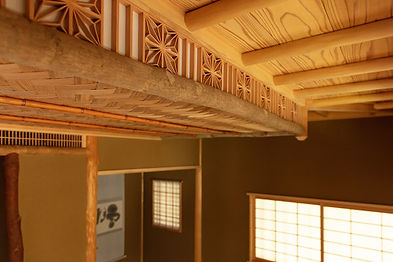
お茶室とは
(お茶室のいろは)
1.お茶室とは

茶室は、日本の茶道において、茶事の主人・亭主が客を招き、茶を出してもてなすために造られる空間である。
お茶を飲むという行為を通して日本的感性と芸術性を表現した茶の湯(茶道)が成立し、それとともに発展したのが茶室である。
茶室の構造や意味を理解することで、「茶室は神聖な場所で、その中では皆平等」「亭主の客に対する敬意」など、茶道をする上で重要な茶の湯の精神を理解することができる。
茶室には、平安時代から嗜まれた書院風のものと、桃山時代の千利休により大成された草庵風のものとがある。
2.書院風の茶室
日本におけるお茶の風習は、西暦794年頃、平安時代にまで遡ると言われている。
当時は、現在の茶道とは異なり、貴族・武士や僧侶たちの遊興の場(闘茶)において茶がふるまわれていたことが、当時の絵画からうかがえる。
こうした場となった座敷が、床(とこ)や棚付書院などを伴った書院造として定式化していくことになり、書院風の茶室(原型は銀閣寺同仁斎と言われている)が生まれた。
この「書院の茶」においては、茶道具や唐物(中国渡来の茶碗、書画、道具など)が使われ、中国文化と禅宗の影響が大きかったと言われており、「草庵の茶」(侘び茶)との大きな違いとなっている。

3.千利休の草庵茶室

15世紀後半から16世紀にかけて、「市中の山居」(都会にいながらにして山里の風情を味わう)を志向する「草庵の茶」(侘び茶)へと移行していく。
村田珠光、武野紹鴎を経て、草庵の茶を大成させたのが千利休。現在における茶室は、一般的にはこの草庵風のものを指す場合が多い。
禅宗の「方丈(一丈四方の意)」から出た四畳半を標準として、それより狭いものを小間の茶室、広いものを広間の茶室という。
茶の湯を完成させた千利休が、それまでの日本の建築空間を革新してつくりあげたのが茶室という空間であり、ゆえに日本の建築において特異な位置を占めている。
だからこそ、現在でも独立した建物として作られる場合に加え、ホテルや公会堂、商業ビルの一角などに造られることもある。
現在進行形で、さまざまな表現の茶室が今も生み出され続けている。
茶室とは、具体的にはどのような空間だろうか? ここでは草庵茶室の基本要素を写真とともに紹介する。
4.茶室の露地(ろじ)
茶室の前には露地と呼ばれる庭・空間があり、茶に招かれた客は露地を通り茶室に向かう。
露地には茶室へ続く飛び石があり、その上を渡りながら、植栽やその風情を眺め、蹲(つくばい)で手口を清める。
露地という屋外の自然を経由して、茶室という非日常空間に向かう。
このことが、茶室への一連の所作を面白くしている。

5.茶室の躙口(にじりぐち)

千利休に始まる草庵茶室の最大の特徴の1つが躙口だ。
およそ60〜70センチ四方で、かがんで身を小さくしないと入れない入り口である。
躙口の由来には諸説あるが、客がたとえ格の高い武士であっても躙口を通るには外に刀を置かねばならず、従って茶室とは、茶をもてなす亭主と客が身分を越えて対等な立場となる非日常空間である、とされている。
また、小さな入口を通ることで、茶室という小空間を大きく感じる効果もあるといわれている。
ちなみに、茶事を催す亭主は、茶道口(給仕をする通い口もある)と呼ばれる別の出入り口を使う。
つまり、お茶室には入り口がふたつ(茶室によっては三つ)あることになる。客専用の躙口と、亭主専用の茶道口。
茶道は流れが大事であり、亭主と客の動線が重ならないように出入り口が配置されている。
6.茶室の炉
茶室では、11月から4月までは、畳の一部を切って設置された炉でお湯を沸かし、5月から10月までは、畳を入れ替えて、炉を塞ぎ、風炉と呼ばれる置き型の炉を使う。
何故入れ替えるのか。これは、正客の位置に座ってみるとよくわかるのだが、火を使い、湯を沸かすことが関係している。
当然、夏は暑い。よって、暑い時期につかう風炉は、火を遠ざけるために客から遠くにおく。逆に、寒い時期は客に近い位置に炉を置くことにより、暖をとる。
亭主の客への気遣いと言えるだろう。

7.茶室の床

掛物や花などを飾る場所を床という。
客は茶室に入るとまず床の前に進み掛物を楽しむ。
床は床柱、床框、相手柱、落掛で構成するが、こうした部材は趣や由緒のあるもの何年もかけて探して使うことも珍しくない。
床の壁は塗り壁とし、場合によって、片側の壁に墨蹟窓や花明窓といっ��た下地窓をつけ、明かりをとりいれる。床面は畳または板張りである。
「床の間」について、さらに詳しく「茶道のすゝめ」で説明しています。
8.茶室の天井
茶室は、亭主が座るところより、客が座るところの方が、天井が高い。
時代劇で見られるように、格の高い人は、高座など下が高くなっているところに座っている。
狭い茶室では畳に高さをつけることができない。
そのため、本来は上座に座るべき客の位置の天井を高くすることで、客の方が格が高いことを表現している。
素材も藁と網代で分けるなど、高さだけでなく、素材やデザインでも差をつける。
これは、数寄屋建築のひとつの特徴でもある。

9.水屋

亭主が茶事の準備や道具の片付けをする場所。
茶室のなかを見渡しても、何かを収納できるような場所はない。
お茶会で使う道具やお水はどこで準備しているのか?
それが、水屋(みずや)と呼ばれる、お茶会の準備をする空間である。
茶器を洗って、拭いて、乾かすまで、この小さい空間で全ての準備が完結する。
水屋は非常に重要で、茶事などを想定して十分な広さを確保することがが望ましい。
![[www.t-a.co.jp][983]C-10.jpg](https://static.wixstatic.com/media/d4f289_df8689d4d74348849147197e143c67bb~mv2.jpg/v1/fill/w_720,h_480,al_c,lg_1,q_80,enc_avif,quality_auto/d4f289_df8689d4d74348849147197e143c67bb~mv2.jpg)